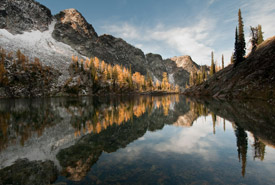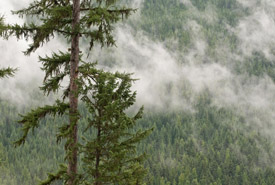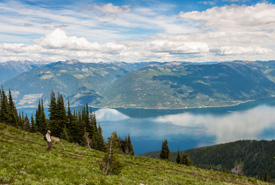Darkwoods

Alpine Lake on Darkwoods, BC (Photo by Bruce Kirkby)
Situated within the traditional territories of the Ktunaxa, Syilx (Okanagan) and Sinixt Peoples, the Darkwoods Conservation Area anchors the Nature Conservancy of Canada’s (NCC’s) work in West Kootenay.
Conserved in 2008 and expanded in 2019, Darkwoods features 63,000 hectares of remote valleys, mountains and lakes, providing essential habitat for dozens of species at risk. The area is central in a network of parks, wildlife management areas and conservation lands that encompass more than 1,100 square kilometres.
Due to its size, Darkwoods provides many different conservation values. With 17 different watersheds intersecting the conservation area, and more than 120 lakes located within its boundaries, Darkwoods provides fresh, clean water to surrounding communities. The forests clean the air, store carbon and offer some buffer to the increasing pressures of climate change. The landscape also acts as a refuge for many rare and endangered plants and animals.

Alpine Lake on Darkwoods, BC (Photo by Bruce Kirkby)
Darkwoods is home to 39 confirmed species at risk, including grizzly bear, wolverine, bull trout, western skink and western screech owl. The vast landscape gives wide-ranging animals, like grizzly bear, the connected space they need to roam freely.
The conservation area also contains some of the most diverse forests in British Columbia, including priceless old-growth stands of vanishing inland temperate rainforest. Discover these forests for yourself through this virtual tour.
Research
There is much to learn from Darkwoods, and NCC is pleased to invite researchers onto the land to conduct studies.
-
Endangered whitebark pine is found at the conservation area’s highest elevations, and since 2011, NCC has been working to research and restore this vulnerable species. After collecting the trees’ seeds, they are nurtured into seedlings at the Nupqu Native Plant Nursery and transplanted back into the high regions of Darkwoods.
-
Grizzly bear biologist Michael Proctor has spent many years mapping the movements of the isolated sub-population of grizzlies that roam Darkwoods. Michael’s research reveals the areas where the bears go to move safely in and around Darkwoods. The results help pinpoint the most important land for conservation, such as the Frog Bear Conservation Corridor, which acts as a key corridor for bears to travel from Darkwoods through the Creston Valley.
-
In partnership with Living Lakes Canada, NCC conducts water quality monitoring within Darkwoods to better understand the health of the aquatic ecosystem.
-
From 2019 to 2023, researchers mapped active wolverine denning areas throughout the Kootenays, including Darkwoods, to improve habitat and inform access management strategies.
-
NCC is working with researchers to study the effects of wildfires that have taken place at the conservation area. This information is used to inform wildfire tree-planting projects for the endangered whitebark pine and fire-resistant species like ponderosa pine, Douglas-fir and western larch.

Misty Darkwoods forest, BC (Photo by Bruce Kirkby)
Carbon storage
NCC acquired Darkwoods from a German Duke, His Royal Highness Duke Carl Herzog von Wurttemberg, who maintained a European-style sustainable forestry operation on the property for more than 40 years. The company’s efforts to minimize the impact of the timber harvest on the overall health of the forest allowed the property to retain much of its ecological value.
Each year, the trees and soil pull even more carbon out of the atmosphere. Conservative estimates suggest that more than two million tonnes of carbon are stored in Darkwoods — equal to the annual carbon footprint of more than 500,000 Canadians.
Through the Darkwoods Forest Carbon Project, we are funding the long-term care and management of Darkwoods. Learn more about the Darkwoods Forest Carbon Project here.
Public access

Hiking on Darkwoods, BC (Photo by Gordon MacPherson)
Darkwoods is accessible for low impact recreational day use from July through September. Permits are required for entry.
Camping, off-road vehicles, snowmobiles, fires, trapping and cutting firewood on the property are prohibited.
There are no marked or maintained trails on this land, so hiking requires route finding in challenging terrain.
The roads into Darkwoods are rough and unpaved; trucks or other 4x4 vehicles are recommended. Due to industrial truck activity on the roads during the work week, a forestry radio with the Resource Roads channels programmed in is required. A radio is also recommended for recreational access on weekends.
How to obtain a free access permit
- Download and complete the Darkwoods General Public Access Permit.
- Email a copy of the completed permit to canadian.rockies@natureconservancy.ca.
- Carry a copy of the permit in your vehicle when you visit Darkwoods. Your permit is only considered valid if we have received the completed permit by email and advance and you have a copy in your vehicle.
Any visitor who fails to email NCC a fully completed and signed permit, and/or neglects to carry a copy of a fully completed and signed permit in their vehicle, will be trespassing.
Contact the Canadian Rockies Program office at 250-342-5521 or canadian.rockies@natureconservancy.ca with any questions.




